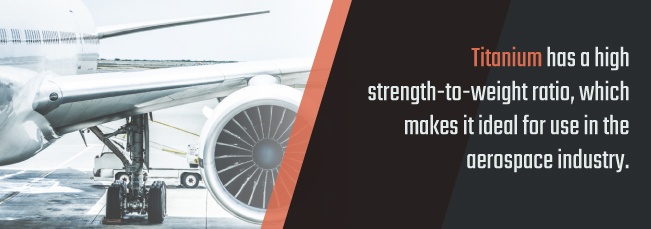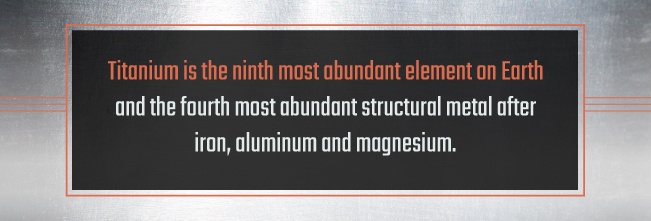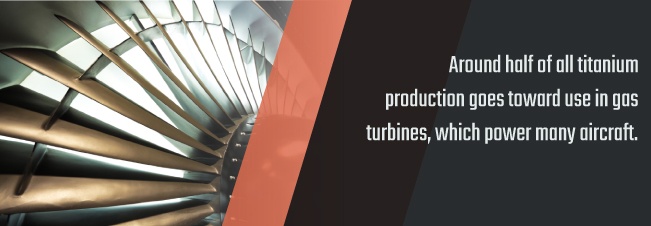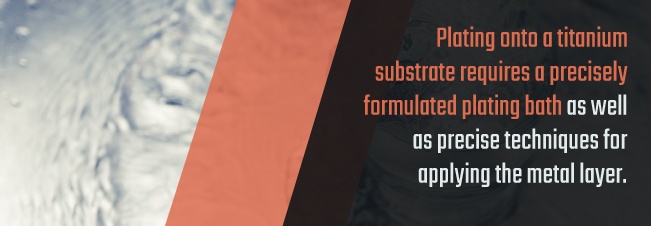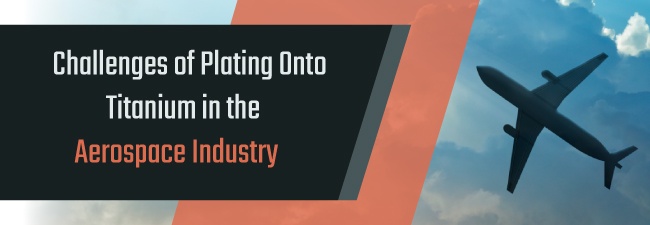
Because of these needs, titanium has emerged as the leading metal used in the aerospace industry, as it’s both strong and lightweight. In other words, it has a high strength-to-weight ratio. Today, the aerospace industry is one of the world’s largest purchasers of titanium and titanium alloys. In fact, the aerospace sector essentially spawned the modern titanium industry.
Titanium has many beneficial characteristics, but these properties also make it challenging to work with. It is an extremely active metal, which makes plating onto it difficult. However, doing so can be highly advantageous, so SPC has developed a process for effectively plating various metals onto titanium substrates for use in the aerospace sector.
History of Titanium in Aerospace
English pastor William Gregor first discovered titanium in 1791, and in 1793, the German chemist M.H. Klaproth gave the substance the name titanium after the Titans from Greek mythology.
It took some time, though, to produce pure titanium. That didn’t happen until the early 1900s. In the 1930s, William J. Kroll of Luxembourg developed a method for extracting large amounts of pure titanium. His technique, called the Kroll process, formed the basis for the modern titanium industry. Kroll is regarded as the father of the titanium industry.
In the late 1940s, the U.S. Air Force began studying titanium and determined that it could be useful due to its high strength-to-weight ratio. The U.S. Department of Defense started to incentivize the production of titanium and kickstarted the industry in the United States. The U.S.S.R., the United Kingdom, Japan and others also launched their titanium industries around this time.
By the 1960s, titanium was also a critical part of the commercial aerospace industry. Other uses for the metal emerged across the automotive, medical, marine and other sectors. The aerospace industry, however, remains the leading user of titanium and its alloys today.
Benefits of Using Titanium
Titanium, a soft, silvery-gray metal, has many properties that make it advantageous to use in the aerospace industry. These characteristics have cemented its role as a critical material for the construction of aircraft, spacecraft, missiles and other aerospace equipment.
- High Strength-to-Weight Ratio
As mentioned earlier, titanium has a high strength-to-weight ratio, which makes it ideal for use in the aerospace industry. This quality is the primary reason it is so prevalent in the aerospace sector. In fact, it has the most efficient ratio of any common metal in temperatures up to 1,100 degrees Fahrenheit. Because it’s so lightweight, it’s easy to get off the ground, but it still has enough strength to be reliable even under high-stress conditions.
- High Tensile and Fatigue Strength
Titanium’s high tensile and fatigue strength are crucial to its usefulness in the aerospace sector. Commercial grade titanium has an average tensile strength of around 63,000 pound-force per square inch (psi). The tensile strength of titanium and its various alloys ranges, though, from 20,000 psi all the way up to 200,000 psi, depending on the alloy.
Titanium alloys also often have high-cycle fatigue strength. The surface finishes used impact actual strength, so applying a finish requires extreme care so that you avoid stress concentrators.
- Low Density
Titanium has a low density, which gives it its high strength-to-weight ratio. It has a density of 4.54 grams per cubic centimeter, which is 60 percent lower than that of iron and 56 percent lower than that of steel.
- High Melting Point
Titanium has a high melting point of 3,047 degrees Fahrenheit or 1,675 degrees Celsius. This enables it to maintain its integrity even in the high-temperature conditions of aircraft engines.
- Easy to Alloy
It is relatively easy to alloy titanium with various other metals, including iron, aluminum, tin, manganese, molybdenum and vanadium. This is because it shares an atomic diameter with many of these common metals. It also exists in two forms, hexagonal close-packed (hcp) at lower temperatures and body-centered cubic (bcc) at higher temperatures. These two properties enable the formation of numerous alloys with beneficial characteristics. The aerospace industry, as well as many other sectors, frequently use titanium alloys.
- Low Coefficient of Thermal Expansion
Titanium expands very little when it experiences temperature changes. Its coefficient of thermal expansion is lower than that of steel, aluminum and copper, so it’s less likely to change its volume, area and shape in the high-temperature conditions of a jet engine and in different altitudes and climates.
The low coefficient of thermal expansion also improves reliability since changes in size and shape can weaken or deform a material, create cracks or even cause overall failure.
- Good Corrosion Resistance
When exposed to air, heat or current, titanium forms an oxide film. This film is relatively chemically inert and is resistant to corrosion as well as many acids and chlorides. It continues to grow as the material is exposed to air over time. This oxide film, however, is the same one that makes it so difficult for other materials to adhere to a substrate during the plating process.
- Abundance
Titanium is the ninth most abundant element on Earth and the fourth most abundant structural metal after iron, aluminum and magnesium. The two primary minerals that contain titanium make up 24 percent of the Earth’s crust. This helps to facilitate a reliable supply of the material and bring costs down.
Benefits of Plating Onto Titanium
Plating other metals onto titanium, while challenging, can enhance some properties of a titanium substrate, making it useful for a wider variety of applications.
Depending on the plating material used, it may increase corrosion resistance, especially in acidic environments, as well as improve the ability to resist surface fatigue. It may also enhance anti-galling properties, fretting, lubricity, solderability and the ability to reflect heat. It may also become more or less conductive depending on the metals used for plating.
Applications of Titanium in the Aerospace Industry
The aerospace industry played a critical role in the creation of the titanium industry, and the metal is central to both the commercial and military aerospace sectors today. Many different kinds of aircraft, including military aircraft, such as the UH-60 Black Hawk helicopter, the F-22 and the F-35, and commercial aircraft, such as the Boeing B787 and the AirBus A380, use titanium and titanium alloys. Countries with large military budgets consider access to titanium a national security issue.
Around half of all titanium production goes toward use in gas turbines, which power many aircraft. You can find titanium alloys in the fans and compressors of these turbines, which reach temperatures in excess of 1000 degrees Fahrenheit. They form parts such as compressor blades, hubs, disks, inlet cases and spacers. The large high-bypass turbofan engines used in wide-body commercial aircraft consist of more than 25 percent titanium by weight.
The basic structures of aircraft and spacecraft, called airframes, use titanium alloys. Most commercial airframes contain between four and eight percent titanium. Military frames often contain higher amounts. The titanium content of these structures can range from as little as two to as much as 30 percent. You’ll find titanium in landing gear supports, fasteners, fail-safe straps, springs and many other components. It also plays a critical role in the wing structure of many aircraft.
Why It’s Difficult to Plate Onto Titanium
Titanium is a highly active metal, which makes working with it challenging.
There is no known method for electroplating or using electroless plating to plate titanium onto another metal. It is too reactive for these processes.
However, it is possible to plate other metals onto titanium, although this process comes with some distinct challenges. Few aerospace plating companies can achieve this feat, but SPC has developed a method for effectively and reliably plating metals such as nickel and platinum onto this highly active metal.
The fact that titanium is so active is the primary challenge associated with using it in plating processes. It has a high electrochemical potential in aqueous solutions and oxidizes quickly if exposed to air. Oxidation will accelerate in the presence of heat or current, which is a fundamental part of the electroplating process. During the plating procedure, it will quickly develop an oxide film that makes it difficult for other metals to adhere to it.
To get around this oxidation challenge, we subject the titanium substrate to extensive preparation. These additional steps add time and complexity to the plating procedure. It requires more equipment and expertise than plating onto many other metals does.
It’s crucial during any plating process to avoid contamination during preparation, as even small amounts of foreign material can cause imperfections or bonding issues. When plating onto titanium, there are more chances for this contamination to occur. SPC has rigorous processes in place to avoid any contamination.
Titanium and its alloys are also particularly susceptible to hydrogen embrittlement. During the plating process, hydrogen may get deposited along with the metal. This hydrogen can cause mechanical failures together known as hydrogen embrittlement. Typically, the stronger the metal, the higher the chance of hydrogen depositing along with the metal.
Plating onto a titanium substrate requires a precisely formulated plating bath as well as precise techniques for applying the metal layer. You need to be extremely thorough and careful throughout the entire process since titanium is such an active metal. It requires a detailed and specialized process to plate onto titanium successfully.
Methods Used for Plating Onto Titanium
To plate another metal onto titanium or one of its alloys, you must prepare the substrate by applying pre-treatments that enable the substances to bond. To accomplish this, the treatments must remove the oxide coating and prevent it from interfering at any point during the plating operation. This requirement presents some substantial challenges, but SPC has developed reliable processes for plating onto titanium.
At the beginning of the process, it’s essential to conduct a thorough cleaning of the substrate so that no contaminants interfere with the plating. Typical cleaning methods include blasting, grinding, vapor degreasing and alkaline cleaning.
You may then need to activate the substance using one of several methods, such as liquid abrasive blasting or electrochemical etching, without the use of heat treatment.
Often, the next step is applying a nickel coating. This coating can improve resistance to corrosion and wear as well as enhance numerous other useful characteristics. Critically, the nickel coating also enables other metals to adhere to the substrate. The nickel coating typically serves this purpose as opposed to acting as the final coating. Additional potentially useful pretreatments include anodic etching, zinc-strike plating and acid pickling.
You can use electroless nickel plating to deposit a nickel coating onto the titanium substrate. Electroless nickel plating uses an autocatalytic chemical reaction, as opposed to an electric current like in electroplating, to apply a nickel-phosphorous alloy evenly onto the substrate. The surface may be vapor-blasted before applying the nickel coating.
After you apply a nickel coating to a titanium or titanium alloy substrate, you can plate other metals, such as platinum, gold, silver or copper, on top of the nickel coating.
Applying a nickel coating before depositing gold plating, for example, helps to prevent the formation of cracks, holes and other defects. It’s essential to completely remove all titanium dioxide before plating to ensure that the coating adheres evenly and continuously. You can also use chemical displacement to plate gold onto titanium. Copper plating might be used to increase electrical conductivity.
The ideal method for plating onto titanium or a titanium alloy depends on which alloy you use and what application the coating and substrate will serve. SPC can help you determine the right plating material and method for your needs.
Solutions for Plating Onto Titanium From SPC
Titanium is not an easy metal to plate onto, but the advantages of using plated titanium or titanium alloys make the extra effort worth it. Plus, when you work with an experienced aerospace plating company likes Sharretts Plating Company, we take care of the hard work for you and provide you with high-quality results every time.
If you need a metal plated onto a titanium or titanium alloy substrate, consider working with SPC. We have developed a process for plating onto titanium that sets us apart as a leader in the field. We also offer a range of other metal finishing solutions, including surface preparation, immersion washing, mass finishing and prototyping. We can provide plating solutions designed to meet the challenges of the aerospace industry as well as the unique requirements of your project.
At SPC, we value customer service and satisfaction, so we are here to answer your metal finishing questions. Browse our website to learn more about us and metal finishing, contact us for a free, no-obligation quote today.


